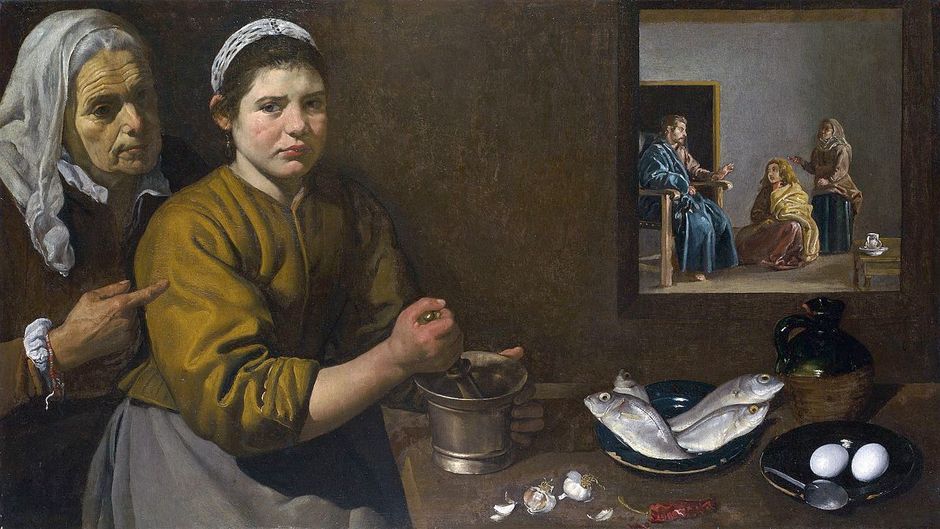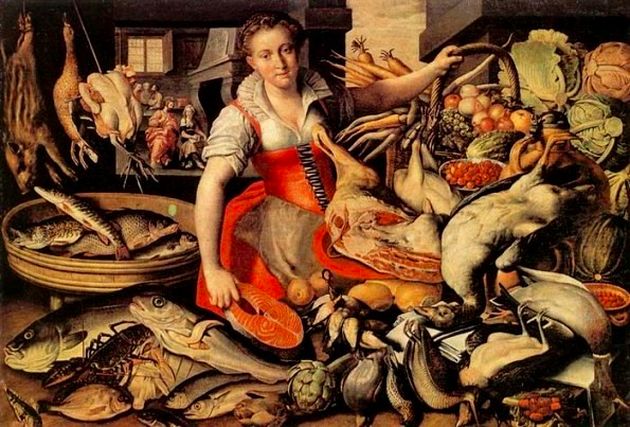Art can help us unwrap the riches of Scripture. Our world was created by the greatest of Artists, after all.
 Christ at Mary and Martha’s House by Diego Velásquez.
Christ at Mary and Martha’s House by Diego Velásquez.
Can art help us read the Bible? Most certainly, I’d argue.
Yet more compelling than an argument are actual examples.
Take the story of Jesus’ visit to Mary and Martha (Luke 10:38-42), for instance. For many, it’s a familiar story. So before speaking on this episode recently, I looked for paintings that portray their encounter.
The result? Insights from some of history’s great artists that helped even long-time Bible readers examine the story afresh.
Rembrandt, for instance, places a large Bible on Mary’s lap, to illustrate that at that moment she was studying with Jesus her teacher.

Their surroundings are dark while the brightest spots are Jesus’ face, Mary’s face, and the book she is studying. The Word makes Mary shine as it reveals Jesus’ face.
Another example: Rubens portrays Jesus’ encounter with Mary outside her house. There are animals, flowers, a setting of bright colors and zestful life.

They indicate the life that flourishes inside and outside Mary when she sits at Jesus’ feet to listen to his words. Her soul is enlightened and her surroundings acquire color.
There’s also Vincenzo Campi’s virtuoso portrait, like a good Italian, of Martha’s culinary skills. I couldn’t find much meaning there, until I noticed how smart Jesus was, as someone who led a group of hungry guys coming from ‘the way’, to not refuse an invitation to dine at Martha’s.

Jesus knew that Martha’s invitation was an offer that could not be refused. That’s one bright Savior, I’d say.
But the painting that best depicts the tension of that story, in my view, is Christ at Mary and Martha’s House by Diego Velásquez.
We see Martha in the foreground, in her kitchen. On the table next to her are fish, eggs, garlic, peppers.
While she cooks Martha ogles what we see reflected on the mirror at the right side of the painting: Jesus in the common room, a blackboard behind him (he is the Teacher, after all), and Mary sitting at his feet.
Martha stares them at a distance while an ugly figure stands behind her. It could be a servant but it seems to me to be actually Satan, who whispers accusations – notice the pointed finger. The same figure stands behind Jesus and Mary, blaming them.
“Martha, you’re doing everything alone. Mary doesn’t care about you. Jesus doesn’t care about you. Nobody cares about you.”
Indeed, Luke tells that Martha voices her complaint to Jesus as an accusation:
Lord, don’t you care that my sister has left me to do the work by myself? Tell her to help me! (Luke 10:40b)
Interesting, isn’t it? Paintings such as these not only give us fresh insights on the biblical passage. They are also a stimulating way to connect with those who listen to a passage being preached or taught. You can notice people leaning forward, their brains waking up.
Over the years Marc Chagall has helped me appreciate the return of the prodigal son. Eugène Burnand has showed me something of the whirlwind of emotions the disciples must have felt as they raced to the empty tomb.
Caravaggio inspired me to grasp the impact of Jesus’ resurrection.
Art can help us unwrap the riches of Scripture. Our world was created by the greatest of Artists, after all.
René Breuel, evangelical pastor in Rome (Italy).

Las opiniones vertidas por nuestros colaboradores se realizan a nivel personal, pudiendo coincidir o no con la postura de la dirección de Protestante Digital.
Si quieres comentar o